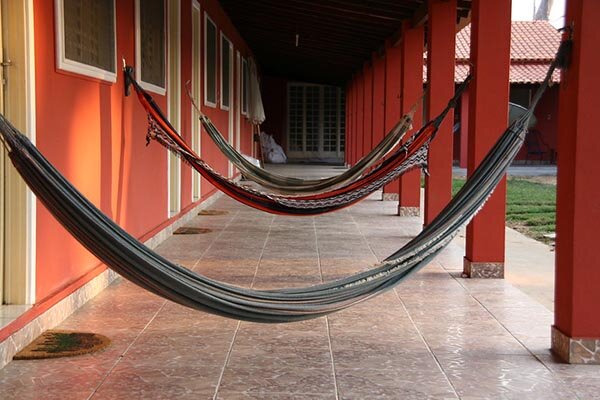Hang Out (Literally) On National Hammock Day
More than just a place to rest and relax, hammocks have an intricate history tied to prisons, disease prevention, sailing, and outer space.
By Marybeth Connaughton
Credit: Flickr/slgckgc
Snoozing in a hammock with a newspaper tented over one’s face and a glass of lemonade in-hand might be the very avatar of a lazy summer day.
But for all its laid back attitude, the hammock itself has put in a lot of work in the thousand years since its first incarnation.
It helped to defend against deadly beasts, aided in fighting life-threatening diseases, and was used as both a weapon and final place of rest. It’s sailed the high seas, scaled the highest mountains, and been to the moon and back. It’s even been to prison.
As a reward, we celebrate National Hammock Day each year on the 22nd of July, its well-deserved day in the sun.
The History of Hammocks
The indigenous people of Central and South America wove the first hammocks out of the bark of “hamack” trees (hence the word hamaca from which the modern word is derived), and later out of the fibers of sisal, or agave plants.
Suspending the resulting cloth between two trees enabled people to sleep above the soil which prevented bites and stings from deadly animals and insects, and allowed them to hang above small fires that could keep them warm.
Centuries later, William Gorgas, a surgeon in the U.S. Army who served as chief sanitary officer during the construction of the Panama canal, found hammocks to be essential to curbing the spread of malaria. Because they could be suspended above the ground, hammocks could be fully ensconced in the netting that proved impenetrable for malaria-transmitting mosquitoes, instead of just partially surrounded like traditional beds. As a result, the workers on the project were protected from infection and construction on the canal continued in a timely manner.
Credit: Flickr/Marco Zanferrari
Perhaps less known is that hammocks were a mainstay of maritime life, proving nothing less than a lifesaver for sailors the world over. Before European explorers brought the hammock back to the continent from the Americas in the mid-16th century, sailors were used to sleeping on the decks of their ships, where they’d get thrown around and injured when the ship hit bad weather. Hammocks lifted them up where they moved in synchronous motion with the ship and with each other. When hung fore to aft or parallel to the ship’s front and back ends, hammocks also prevented and provided relief from seasickness by allowing the rolling motion of the waves to pass under the sailors.
On British ships, hammocks were hung on the sides of the vessels during the day underneath netting to help protect from enemy fire. If a sailor fell overboard, the hammock, made of canvas, could serve as a floatation device for up to 24 hours. And, if a sailor died at sea, the hammock could be used as a coffin of sorts, with the body sewn inside of it, the final stitch being strung through the nose.
Later, in 1775, British warships were decommissioned and converted into floating prisons along the river Thames when revolution in the American colonies made it impossible to send criminals there. Like sailors before them, prisoners slept in hammocks.
Credit: Unsplash/Steph Q
In fact, hammocks were used in lieu of beds in traditional prisons in the U.K. until 1905, when it was discovered that the hooks used to hang them were also being utilized as weapons in efforts to escape.
Though they were implemented largely as a space-saving measure, hammocks may have provided prisoners with their sole bit of luxury in the form of peaceful sleep. In a recent study, 12 healthy males were observed while taking two different kinds of naps: one while sleeping stationary, and one while rocking. The study showed that the rocking motion, such as the kind created by hammocks, accelerated the onset of sleep and lengthened the amount of time spent in the N2 stage, where muscles become more relaxed. Basically, rocking sets your brain waves so that you fall asleep faster and sleep more deeply for longer.
Hammocks still play a role in some prisons. To this day, inmates in a prison just outside of Valladolid, Mexico in the Yucatán Peninsula, weave them while behind bars. People the world over seek out the quality and comfort of their nylon creations.
Credit: Unsplash/Linda Segerfeldt
Hammocks have been a source of comfort even for those light years from home. The Apollo lunar module, whose 11th mission famously sent the first humans — American astronauts Buzz Aldrin and Neil Armstrong — to the moon, was a cramped and inhospitable place to sleep. Pipes, wires, and machinery were all exposed without panels in every effort to keep the craft’s weight at a minimum. The two astronauts had to sleep in what were basically upright sitting positions, right above the craft’s rumbling engines. To remedy this, hammocks made of teflon fabric were hung one above the other in an “X” formation, so that astronauts Al Bean and Pete Conrad, who took the subsequent Apollo 12 mission to the moon, could sleep peacefully among the stars.
For those who prefer a midway point between sea and sky, vertical camping is a popular sport in which rock climbers secure their hammocks at the tops of, or even on the sides of mountains. In the 1950s, the rock climber Warren Harding and his team were among the first groups to scale El Capitan in Yosemite National Park. They secured their hammocks in crevices or on the sides of the mountains to sleep periodically during days-long climbs to the mountain’s peak.
But you don’t have to have a mountain — or even two trees — to use a hammock. There are still plenty of options for those who are content to wander no farther than their own backyards. Whether you want to spend $35,000 or just $35, you can find hammocks that are free-standing, suspended, or come with their own shade covering. Don’t like the traditional woven rope base? Try a quilted or pillow-top one. They also make hammock chairs for those with limited space, and yes, even your dog or cat can have their own mini version.
The trick to getting (and staying) in a hammock is to lower yourself slowly into its center while holding the edge closest to you with one hand. Then you slightly lift the opposite edge with your other hand and swing your legs over.
Credit: Flicker/anoldent
Once you’ve mastered the art of climbing into a hammock and nestling in its comfy cocoon, you might never want to return to spending your days vertically. So this July 22, spare some time for one of mankind’s most simple, yet ingenious inventions. The hammock has earned it.
























